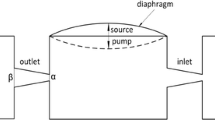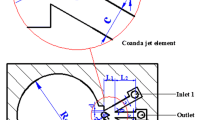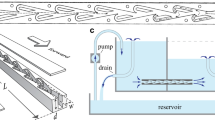Abstract
The efficiency of the valve-less rectification micropump depends primarily on the microfluidic diodicity (the ratio of the backward pressure drop to the forward pressure drop). In this study, different rectifying structures, including the conventional structures (nozzle/diffuser and Tesla structures), were investigated at very low Reynolds numbers (between 0.2 and 60). The rectifying structures were characterized with respect to their design, and a numerical approach was illustrated to calculate the diodicity for the rectifying structures. In this study, the microfluidic diodicity was evaluated numerically for different rectifying structures including half circle, semicircle, heart, triangle, bifurcation, nozzle/diffuser, and Tesla structures. The Lattice Boltzmann Method (LBM) was utilized as a numerical method to simulate the fluid flow in the microscale. The results suggest that at very low Reynolds number flow, rectification and multifunction micropumping may be achievable by using a number of the presented structures. The results for the conventional structures agree with the reported results.








Similar content being viewed by others
References
Bardell R, Sharma R, Forster FK, Afromowitz MA, Penney R (1997) Designing high-performance micro-pumps based on no-moving-parts valves. In: Lin L, Goodson KE et al (eds) Microelectromechanical systems (MEMS), Proceedings of the ASME IMECE (International Mechanical Engineering Congress and Exposition) vol DSC-234/HTD-354. Dallas, pp 47–53
Benzi R, Succi S, Verassola M (1998) The lattice Boltzmann equation-theory and application. Future Generation Computer Systems 14:209–214
Bhatnagar PL, Gross EP, Krook M (1954) A model for collision processes in gases, I. Small amplitude processes in charged and neutral one-component system. Phys Rev 94:511–525
Bouzidi M, Firdaouss M, Lallemand P (2001) Momentum transfer of a Boltzmann lattice fluid with boundaries. Phys Fluids 13:345–3452
Chen Y, Kang S, Wu L, Lee S (2008) Fabrication and investigation of PDMS micro-diffuser/nozzle. J Mater Process Technol 198:478–484
Chopard B, Droz M (1998) Cellular automata modeling of physical systems. Cambridge University Press, Cambridge
d’Humieres D, Ginzburg I (2002) Multiple-relaxation-time lattice Boltzmann models in three dimensions. Phil Trans R Soc Lond A 360:437–451
Foster FK, Bardell L, Afromowitz MA, Sharma NR, Blanchard A (1995) Design, fabrication and testing of fixed-valve micro-pumps. Proceeding of the ASME Fluids Engineering Division, ASME 234:39–44
Freudiger S (2009) Entwicklung eines parallelen, adaptiven, komponentenbasierten Strömungskerns für hierarchische Gitter auf Basis des Lattice-Boltzmann-Verfahrens. Ph. D. dissertation. Technische Universität Braunschweig, Braunschweig, Germany
Gamboa AR, Morris CJ, Forster F (2005) Improvements in fixed-valve micropump performance through shape optimization of valves. J Fluid Eng 127:339–346
Gerlach T, Wurmus H (1995) Working principles and performance of the dynamic micropump. Sens Actuators A 50:135–140
Gerlach T, Schuenemann M, Wurmus H (1995) A new micropump principles of the reciprocating types using pyramidic microflow channel as passive valves. J Micromech Microeng 5:199–201
Geschke O, Klank H, Tellemann P (2004) Microsystem engineering of Lab-on-a-Chip devices. Wiley-VCH, Weinheim
Gravesen P, Branebjerg J, Jensen OS (1993) Microfluidics: a review. J Micromech Microeng 3:168–182
Jiang XN, Zhou ZY, Huang XY, Li Y, Yang Y, Liu CY (1998) Micronozzle/diffuser flow and its application in microvalveless pumps. Sens Actuators A 70:81–87
Koch T, Evans AGR, Brunschweiler A (1998) The dynamic micropump driven with screen printed PZT actuator. J Micromech Microeng 8:119–122
Laser DJ, Santiago JG (2004) A review of micropumps. J Micromech Microeng 14:35–64
Mei R, Yu D, Shyy W (2002) Force evaluation in the lattice Boltzmann method involving curved geometry. NASA/CR-2002-211622, ICASE Report No. 2002-22
Nguyen N, Huang X, Chuan TK (2002) MEMS-micropumps: a review. J Fluid Eng 124:384–392
Olsson A, Stemme G, Stemme E (1995) A valve-less planar fluid pump with two pump chambers. Sens Actuators A 46–47:549–556
Olsson A, Stemme G, Stemme E (1996) Diffuser-element design investigation for valve-less pumps. Sens Actuators A 57:137–143
Olsson A, Stemme G, Stemme E (1997a) Simulation studies of diffuser and nozzle elements for valve-less micropumps. Transducers 97, June 16–19, Chicago, USA
Olsson A, Enoksson P, Stemme G, Stemme E (1997b) Micromachined flat-walled valve-less diffuser pumps. J Microelectromech Syst 6(2):161–166
Olsson A, Stemme G, Stemme E (2000) Numerical and experimental studies of flat-walled diffuser elements for valve-less micropumps. Sens Actuators 84:165–175
Pingen G (2005) Topology and shape optimization of fluid-structure interaction problems. Thesis proposal, Department of Aerospace Engineering Sciences, University of Colorado
Qian YH, d’Humieres D, Lallemand P (1992) Lattice BGK models for Navier Stokes fluid flow. Europhys Lett 17:479–484
Rosa S, Pinho FT (2006) Pressure drop coefficient of laminar Newtonian flow in axisymmetric diffusers. Int J Heat Fluid Flow 27:319–328
Runstadler PW, Dolan FX, Dean RC (1975) Diffuser data book. Creare, New Hampshire
Schäfer M, Turek S (1996) Benchmark computations of laminar flow around a cylinder. In: Schäfer E (ed) Flow simulation with high-performance computers II. DFG priority research program results 1993–1995. Notes in Numerical Fluid Mechanics, vol 52. Vieweg, Wiesbaden, pp 547–566
Singhal V, Garimella SV, Raman A (2004a) Microscale pumping technologies for microchannel cooling systems. App Mech Rev 57(3):191–221
Singhal V, Garimella SV, Murthy J (2004b) Low Reynolds number flow through nozzle-diffuser elements in valveless micropumps. Sens Actuators A 113:226–235
Stemme E, Stemme G (1993) A valve-less diffuser/nozzle based fluid pump. Sens Actuators A 39:159–167
Succi S (2001) The lattice Boltzmann equation for fluid dynamics and beyond. Oxford University Press, Oxford
Van de Pol FCM (1989) A pump based on micro-engineering techniques. Thesis, University of Twente, Enschede, The Netherlands
Wang Y, Hsu J, Kuo P, Lee Y (2009) Loss characterization and flow rectification property of diffuser valves for micropumps application. Int J Heat Mass Transf 52:328–336
White FM (1999) Fluid mechanics. WCB/McGraw-Hill, Singapore
Yang K, Chen I, Shew B, Wang C (2004) Investigation of the flow characteristics within a micronozzle/diffuser. J Micromech Microeng 14:26–31
Yu D, Mei R, Luo L, Shyy W (2003) Viscous flow computations with the method of lattice Boltzmann equation. Progress Aerosp Sci 39:329–367
Acknowledgments
The research described, in this paper, was supported by the National Science Foundation (NSF), Grant No.: OISE-0530203. Additionally, we are grateful for the technical assistance of Christian Janßen and Sören Freudiger.
Author information
Authors and Affiliations
Corresponding author
Rights and permissions
About this article
Cite this article
Fadl, A., Zhang, Z., Geller, S. et al. The effect of the microfluidic diodicity on the efficiency of valve-less rectification micropumps using Lattice Boltzmann Method. Microsyst Technol 15, 1379–1387 (2009). https://doi.org/10.1007/s00542-009-0901-7
Received:
Accepted:
Published:
Issue Date:
DOI: https://doi.org/10.1007/s00542-009-0901-7




